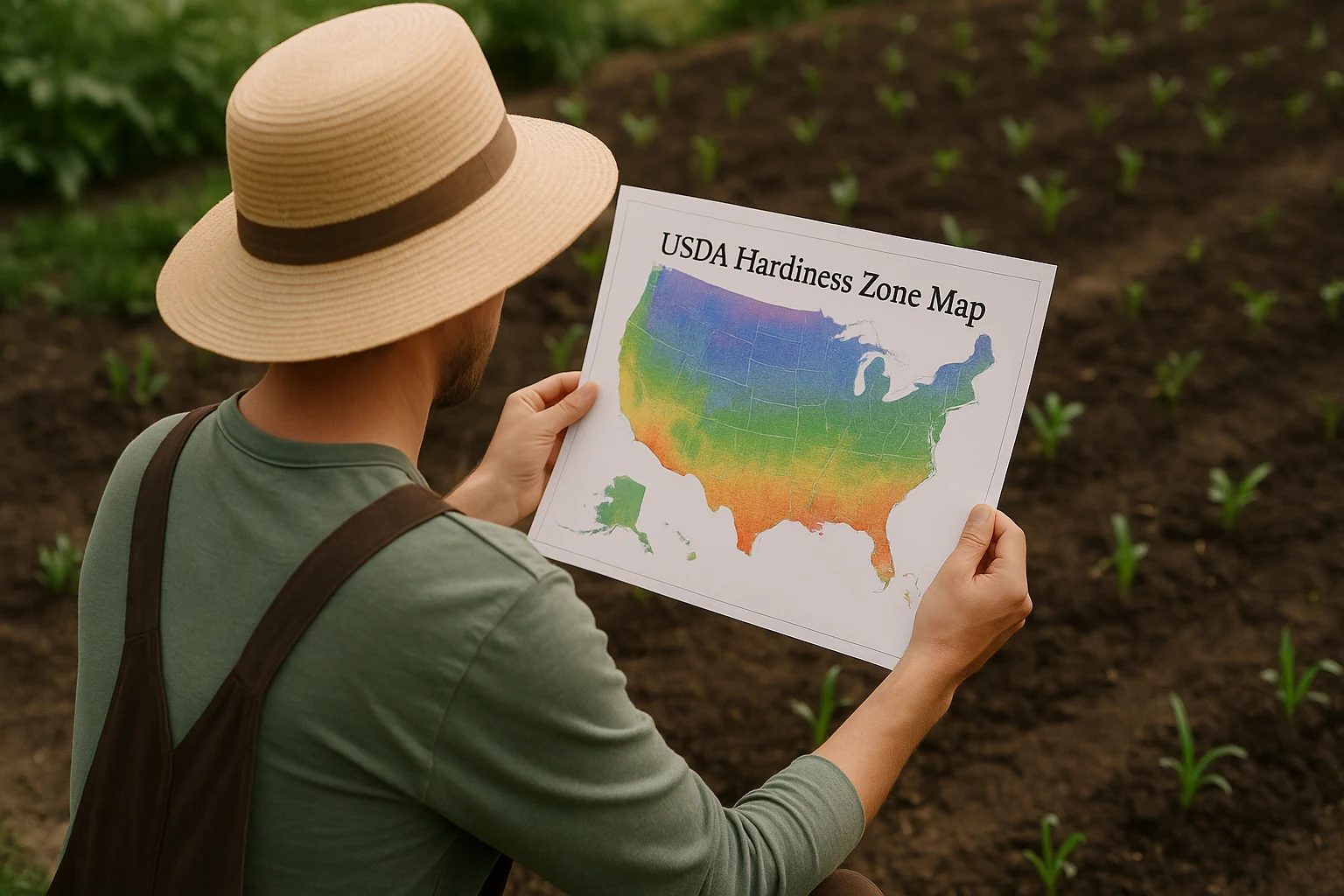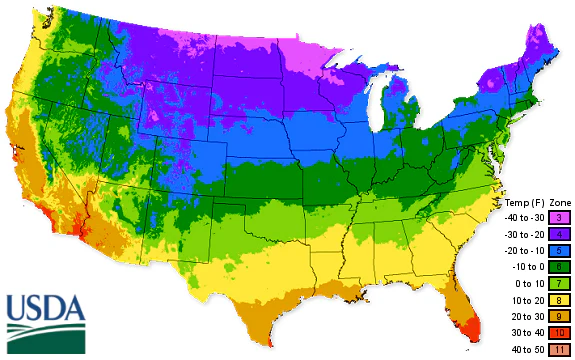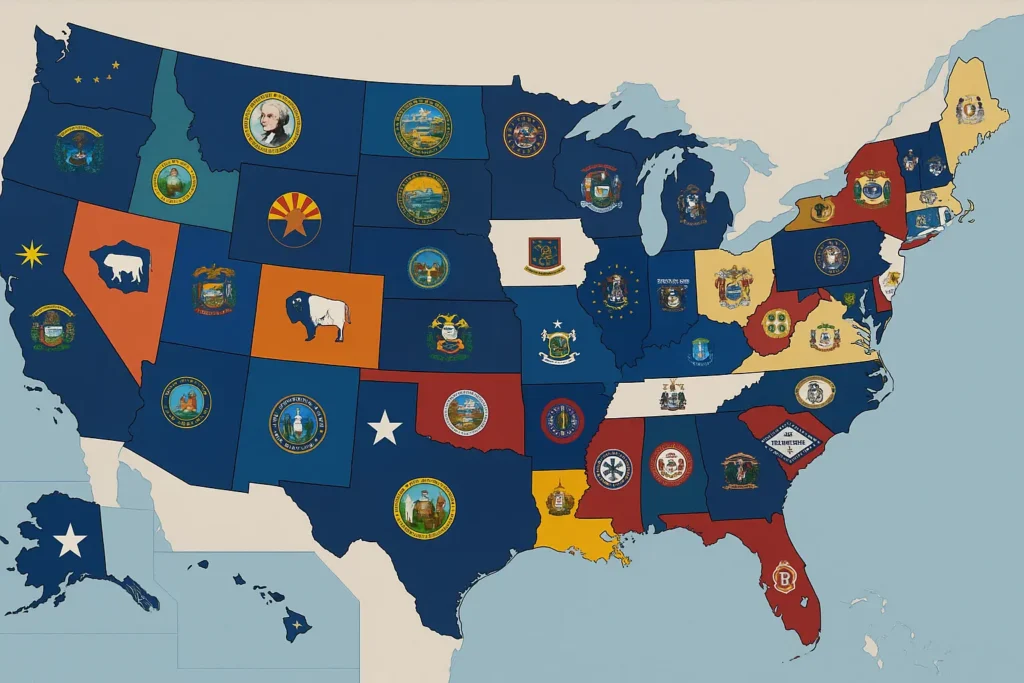What Planting Zone Am I In? USDA Growing Zones by State and City

When starting a garden, one of the first questions you might ask yourself is, what planting zone am I in? Knowing your planting zone is more than just trivia — it’s the foundation for choosing plants that will thrive in your specific climate. The USDA hardiness zones, often simply called gardening zones, are a guide based on the average minimum winter temperatures across different regions.
Each zone helps gardeners make smarter decisions about which plants can survive and flourish through the seasons. But understanding your zone isn’t always as straightforward as it sounds. Microclimates, urban heat islands, and shifting weather patterns mean that a planting zone lookup is a helpful starting point, not an absolute rule. Even two neighborhoods within the same city can experience slight variations that make one better suited for tomatoes and the other for kale. Knowing your zone gives you the best chance at success — but leaving a little room for intuition and adjustment often makes all the difference.
Table of Contents
What Are USDA Plant Hardiness Zones?
USDA planting zones, also known as USDA plant hardiness zones, help gardeners understand which plants can survive winter in their region. These zones are based on the average minimum winter temperatures.
The system divides North America into 13 zones. Zone 1 is the coldest, while Zone 13 is the warmest. Each zone spans 10°F and is often split into “a” and “b” subzones for more detail.
It’s a helpful starting point—but not always the full story. Microclimates, elevation, and even city heat can cause real-world conditions to differ slightly from what the map suggests. Still, knowing your USDA zone makes choosing plants a lot easier.
The USDA’s official interactive map allows users to determine their planting zones based on average annual minimum winter temperatures. It serves as the standard reference for gardeners and growers across the United States.
What Planting Zone Am I In?
Select your state to find the average USDA planting zone and a quick planting tip.
Plant Hardiness Subzones
Each USDA plant hardiness zone is further divided into two subzones: “a” and “b.” These subzones represent a 5°F difference in average minimum winter temperatures. For example, Zone 6a typically ranges from -10°F to -5°F, while Zone 6b covers -5°F to 0°F.
The subzones offer a bit more precision, especially in areas with variable climates. However, not every gardener finds them essential. Some treat them as helpful detail, while others rely more on observation—how their yard actually behaves during winter.
In practice, the difference between a and b might not drastically change what you can grow, but it can matter for more sensitive plants, particularly perennials or fruiting trees. For borderline plants, knowing your subzone could be the nudge between thriving and just surviving.
Lookup Planting Zones by State
If you’re trying to figure out what planting zone am I in, the most reliable approach is to start with your state. While national USDA zone maps offer a general view, they often overlook regional shifts, elevation differences, and urban heat effects. That’s why a simple, location-based planting zone lookup—organized by state—is more practical for gardeners planning what and when to grow.
Some gardeners swear by using ZIP-code-specific tools, but many of them come back to the basics: knowing your state’s primary planting zones first, then adjusting slightly for your microclimate. For example, someone living in a cooler corner of California might be in Zone 8b, while their neighbor just 20 miles away enjoys Zone 10a. It’s subtle—but it can affect everything from first frost dates to the right tomato variety.
Below, you’ll find a scannable, alphabetically sorted list of U.S. states. Click on your state to see a full breakdown of its USDA zones, recommended planting dates, and what grows best in your climate. Even if you’ve been gardening for years, the zone you think you’re in might surprise you—especially with shifting climate patterns in recent years.
What Planting Zone is Alabama?
What Planting Zone is Alaska?
What Planting Zone is Arizona?
What Planting Zone is Arkansas?
What Planting Zone is California?
What Planting Zone is Colorado?
What Planting Zone is Connecticut?
What Planting Zone is Delaware?
What Planting Zone is Florida?
What Planting Zone is Georgia?
What Planting Zone is Hawaii?
What Planting Zone is Idaho?
What Planting Zone is Illinois?
What Planting Zone is Indiana?
What Planting Zone is Iowa?
What Planting Zone is Kansas?
What Planting Zone is Kentucky?
What Planting Zone is Louisiana?
What Planting Zone is Maine?
What Planting Zone is Maryland?
What Planting Zone is Massachusetts?
What Planting Zone is Michigan?
What Planting Zone is Minnesota?
What Planting Zone is Mississippi?
What Planting Zone is Missouri?
What Planting Zone is Montana?
What Planting Zone is Nebraska?
What Planting Zone is Nevada?
What Planting Zone is New Hampshire?
What Planting Zone is New Jersey?
What Planting Zone is New Mexico?
What Planting Zone is New York?
What Planting Zone is North Carolina?
What Planting Zone is North Dakota?
What Planting Zone is Ohio?
What Planting Zone is Oklahoma?
What Planting Zone is Oregon?
What Planting Zone is Pennsylvania?
What Planting Zone is Rhode Island?
What Planting Zone is South Carolina?
What Planting Zone is South Dakota?
What Planting Zone is Tennessee?
What Planting Zone is Texas?
What Planting Zone is Utah?
What Planting Zone is Vermont?
What Planting Zone is Virginia?
What Planting Zone is Washington?
What Planting Zone is West Virginia?
What Planting Zone is Wisconsin?
What Planting Zone is Wyoming?
Some of these states span as many as three or four different USDA zones. Others, like Delaware or Rhode Island, are relatively consistent. But no matter where you are, getting familiar with your zone—and how it shifts within your state—can be the first step toward a more successful, better-timed garden.
Top Cities & Their Planting Zones
When someone asks, “What planting zone am I in?” they’re often not just looking for a number — they want reassurance that their location, climate, and growing conditions are understood. And for many, especially those in urban or suburban areas, the question becomes more specific: “What planting zone is Chicago?” or “What planting zone is Dallas, Texas?”
To help answer those questions, here’s a reference table with some of the most searched-for U.S. cities and their associated USDA hardiness zones. Keep in mind, though, that city planting zones can shift slightly depending on microclimates, elevation, or even the presence of buildings and concrete. A neighborhood in downtown Atlanta might warm up faster than a rural area just 15 miles outside the city. So while the zones are helpful, they’re not infallible — and gardening rarely is. Test your soil’s pH before planting.
| City | Zone(s) | State |
|---|---|---|
| New York City | 7b | New York |
| Chicago | 6a–6b | Illinois |
| Dallas | 8a | Texas |
| San Diego | 10a–10b | California |
| Atlanta | 8a | Georgia |
| Seattle | 8b | Washington |
| Denver | 5b | Colorado |
| Phoenix | 9b–10a | Arizona |
| Boston | 6b–7a | Massachusetts |
| Miami | 10b–11a | Florida |
Understanding the zone for your city helps you make more informed decisions about what to plant and when. But it’s never a perfect science. Some gardeners in Chicago swear they’ve overwintered rosemary outside — technically a zone 8 plant — by planting it near a sunny south-facing wall. Meanwhile, a friend in Dallas may lose tomatoes early due to an unexpected cold snap in what should be a warm zone.
That’s part of the beauty and frustration of gardening: the mix of planning, unpredictability, and discovery. Use this chart as your baseline, but don’t be afraid to experiment just a little.
So the next time you wonder, “What planting zone is San Diego?” or “What planting zone is Atlanta?”, remember: it’s not just about temperature averages — it’s about how you adapt, observe, and respond to your garden’s unique personality.
What Can You Grow in Each Zone?
When asking what planting zone am I in, the next natural question tends to be — what exactly can I grow here? The answer isn’t always straightforward. While planting zones give a useful framework, the truth is that local weather patterns, soil quality, and even a gardener’s personal approach can shift what actually thrives. Use our Plant Spacing Calculator to plan your garden by zone
Still, understanding what grows in each zone provides an essential starting point. Let’s take a look across the main U.S. zones:
Zone 3–5: Cool-Weather Champions
| Zone Range | Zone 3–5: Cool-Weather Champions |
|---|---|
| Climate Traits | Cold winters and short growing seasons dominate these northern zones, limiting the window for planting but allowing frost-hardy crops to thrive. |
| Best Crops | Root vegetables such as carrots, beets, and turnips, along with leafy greens like kale and spinach. Garlic, onions, and cabbage also perform reliably. |
| Special Notes | Tomatoes and other warmth-loving crops can be grown with the help of cloches or cold frames, especially in Zone 5 — though not all gardeners find the payoff worth the effort. |
| Growing Tip | Focus on crops that can tolerate frost and mature quickly. Plan for season extension methods if trying to grow beyond the basics. |
Zone 6–7: Versatile Grower Zones
| Zone Range | Zone 6–7: Versatile Grower Zones |
|---|---|
| Climate Traits | Mild to moderately cold winters with a long, balanced growing season. Ideal for a wide variety of crops. |
| Best Crops | Tomatoes, beans, cucumbers, squash, corn, lettuces, peppers, broccoli, and culinary herbs like basil and parsley. |
| Special Notes | Zone 6 can occasionally have late frosts; Zone 7 offers a longer season but requires smart watering during dry spells. |
| Growing Tip | Use row covers or start indoors for early crops. Interplant cool- and warm-season crops for back-to-back harvests. |
Zone 8–10: Heat-Loving & Tropical Growers
| Zone Range | Zone 8–10: Heat-Loving & Tropical Growers |
|---|---|
| Climate Traits | Long, hot summers and mild winters. Often suited to year-round growing or multiple crop cycles. |
| Best Crops | Okra, eggplant, sweet potatoes, watermelon, citrus trees, avocado, guava, and heat-tolerant herbs like oregano and rosemary. |
| Special Notes | Heat can be excessive for cool-season crops; shade cloth or early planting may be necessary for greens and lettuce. |
| Growing Tip | Plan summer breaks for heat-sensitive plants and take advantage of fall and winter to grow cool-season varieties instead. |
Calculate how much fertilizer your zone crops need.
FAQ – Planting Zone Basics
Understanding USDA planting zones is a helpful starting point for gardeners, but it’s not always as simple as finding your zone and calling it a day. Below are answers to some of the most common planting zone FAQs, including how to find your planting zone, whether zones shift over time, and just how precise these zones actually are.
What planting zone am I in?
Your planting zone depends on your average annual minimum winter temperature. The USDA divides the U.S. into 13 planting zones, each split further into “a” and “b” subzones. The easiest way to find your planting zone is to enter your ZIP code into the USDA Plant Hardiness Zone Map or use a planting zone lookup tool. However, many gardeners also rely on local experience — neighbors, nurseries, or their own trial-and-error — especially in areas where elevation or microclimates play a role.
Can planting zones change over time?
Yes, planting zones can — and do — change. Climate patterns are not static, and the USDA periodically updates the map to reflect warmer winters, shifting weather trends, or more detailed data. A zone that was 6a in 1990 might now be labeled 6b or even 7a. However, some growers still use older maps, claiming they feel more in tune with what actually grows well in their garden. So while zones do change on paper, how gardeners interpret and use them often varies.
How accurate are USDA planting zones?
Planting zones are a helpful guideline, not a guarantee. They’re based solely on average low winter temperatures and don’t consider other important factors like humidity, heat, rainfall, soil conditions, or sudden cold snaps. For that reason, two gardens in the same zone but different regions can behave very differently. Most experienced gardeners treat USDA zones as a useful starting point, but they often adapt based on firsthand knowledge of what their specific patch of land allows — or resists.
Conclusion: Why Planting Zone Lookup Matters
Gardening rarely rewards guesswork. While experience and intuition play their role, knowing your planting zone gives you a foundation to plan around. It narrows down what will thrive, when to start planting, and how to work with—not against—your local climate.
Of course, not everyone agrees on when to push boundaries. Some gardeners swear by stretching their growing season beyond their zone; others stay firmly within it. That’s part of the beauty—there’s room for both structure and experimentation.
Still, a reliable planting zone lookup is where it begins. If you’re unsure what applies to your region, take a moment to visit your state-specific guide. From there, explore our planting tools, crop calendars, and recommendations tailored to your zone. Small adjustments made early in the season can lead to healthier, more resilient gardens all year long.



